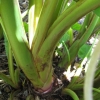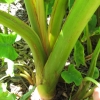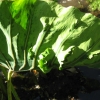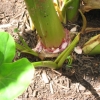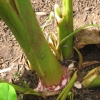Use As Food
Popular for red poi, some of the so-called Lehua red poi are being made from this variety, especially on Oahu; the leaves are good for lū ‘au. Taro of this family are common grown in lo‘i (wetland), and are very tough with a resistance to root rot. Goup piko are known to make good poi.
Distribution
Found occasionally in lo‘i (wetland patches) with other varieties like Piko Kea and Piko ‘Uli‘uli.
General Characteristics
Medium in height, erect, moderately stocky, maturing within 9 to 12 months, producing from 5 to 10 ‘ohā; distinguished from other Piko varieties by leaves' outgrowths of dark green crinkled tissue on lower surface of Lau or lū ‘au (Leaf blade).
Ha (Petiole)
60 to 95 cm. long, yellowish green with faint pinkish cast, usually faintly red at edge, a pink ring at kōhina (base) with pale pink for 3 to 4 cm above.
Lau or Lu'au(Leaf Blade)
40 to 60 cm. long, 25 to 35 cm. wide, 25 to 40 cm. from tip to base of sinus (māwae), arrow head shaped, tapering to a sharp point, concave (curve inward), firm-chartaceous (paper like), dark green with pinkish cast when young; margins decidedly wave-like (undulate): round leaf section (lobes) acute with outgrowths of dark green crinkled tissues on lower surface, the lihi māwae (sinus) is deep and wide.
'I'o kalo (Corm)
the flesh is lilac-purple with light purple fibers; skin pink.
Pua (Flower)
Remarks




